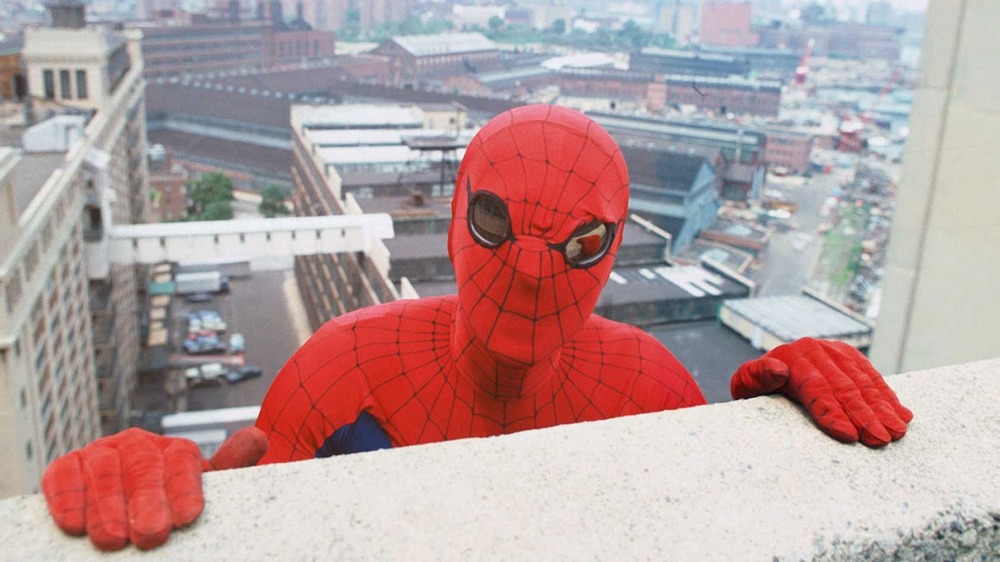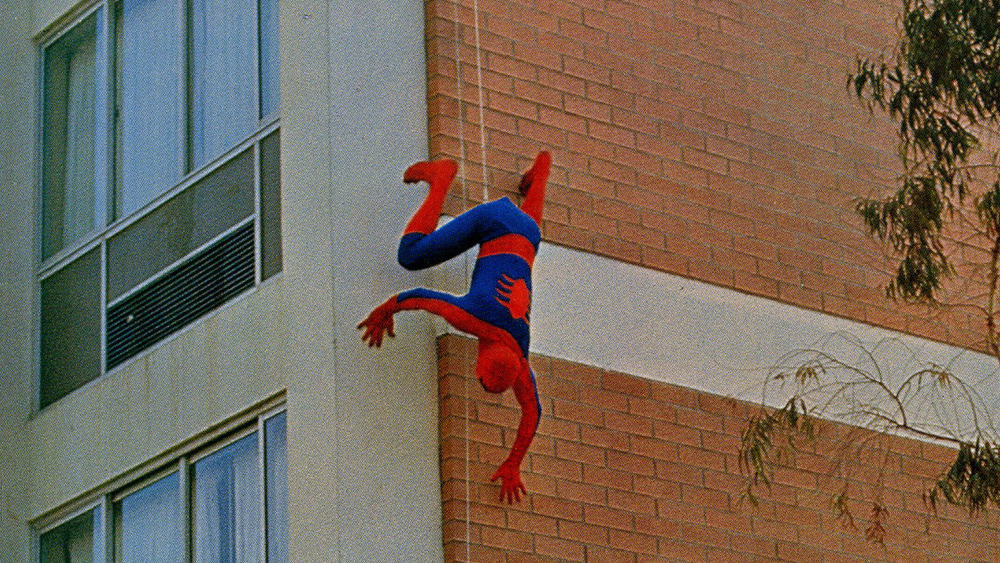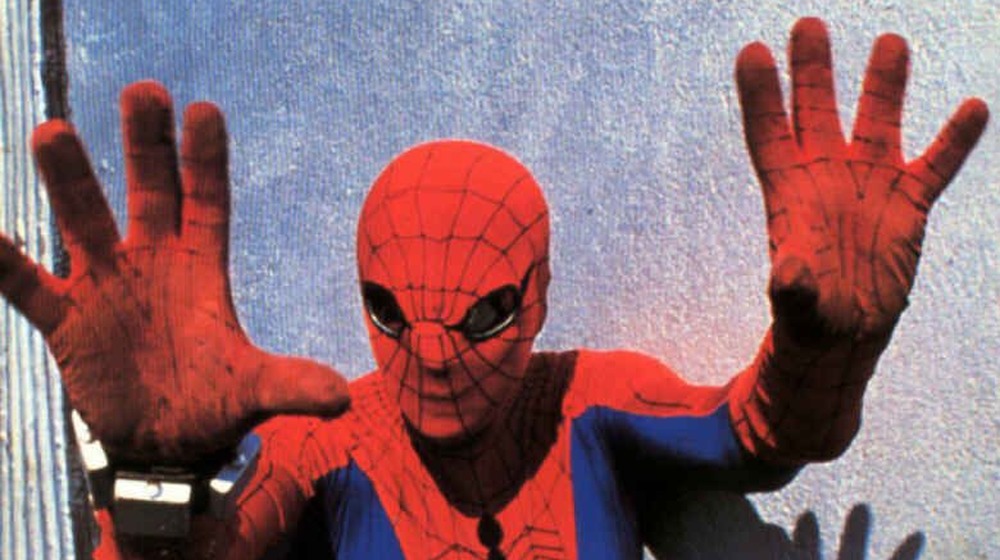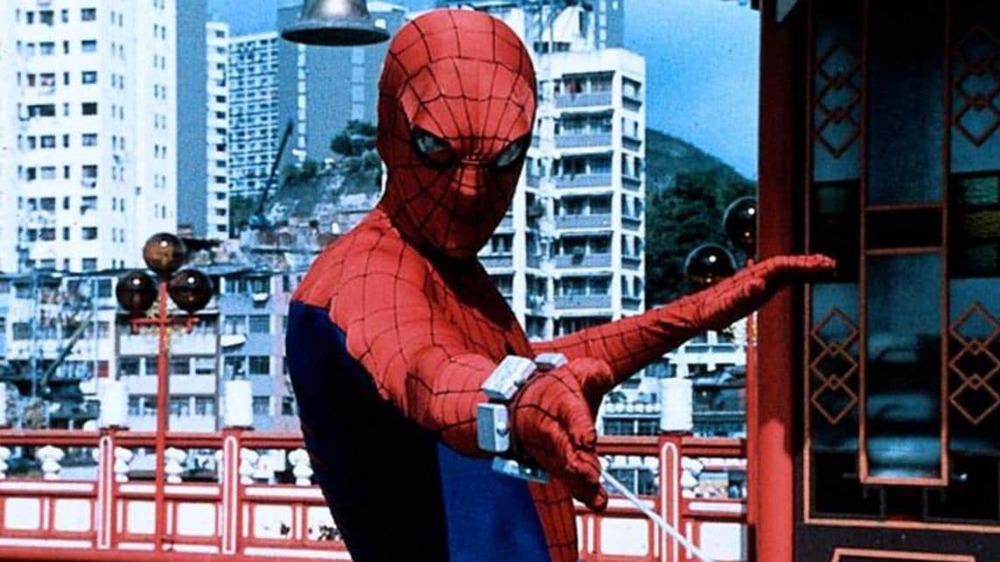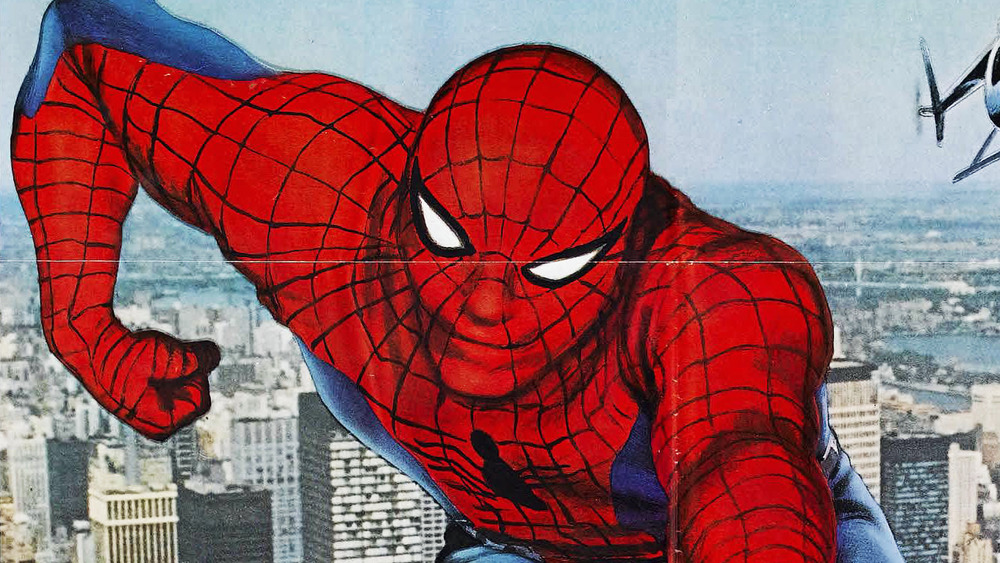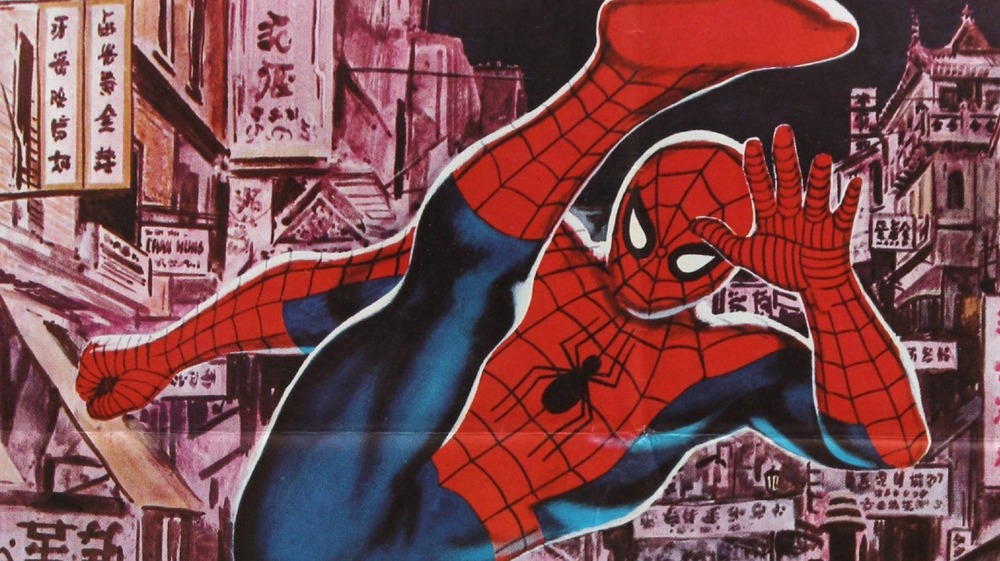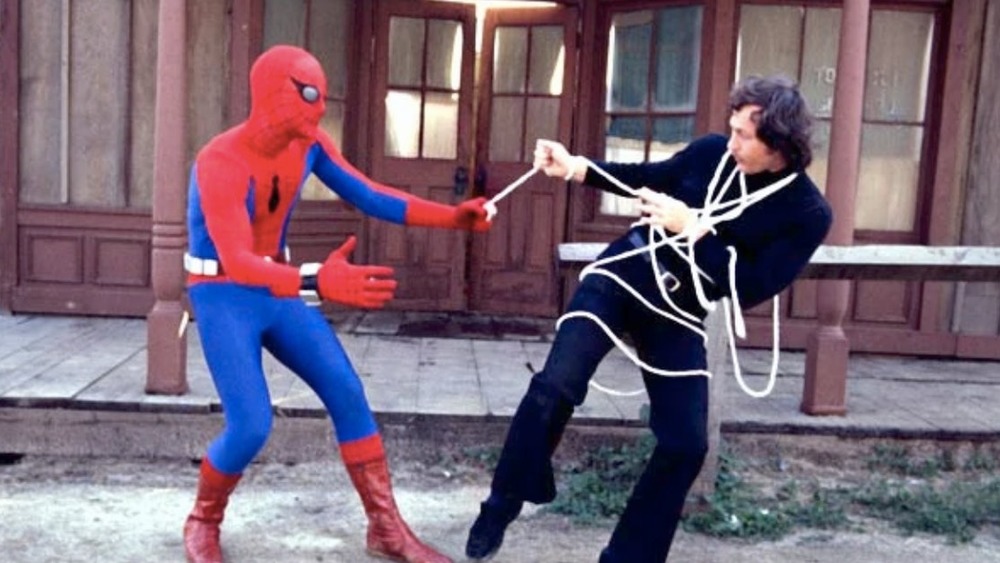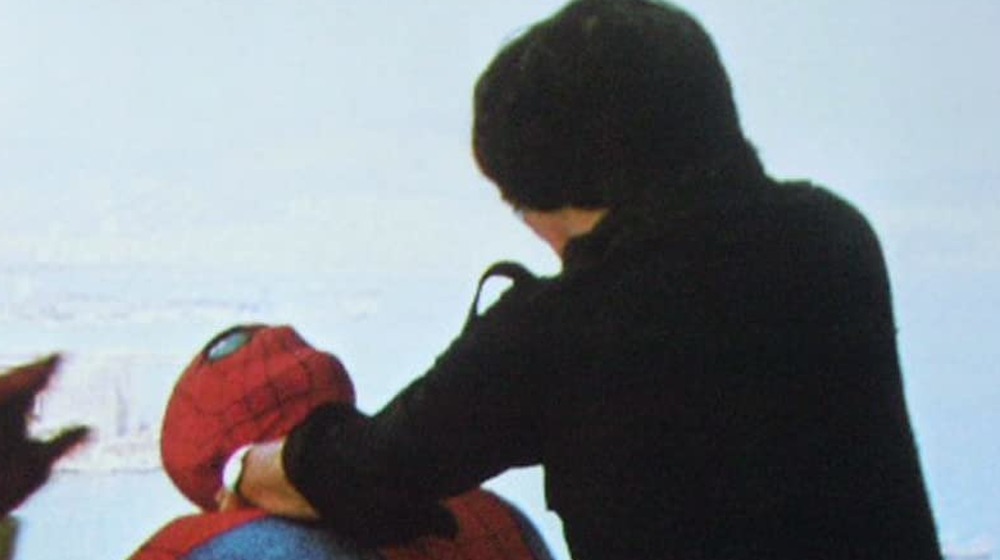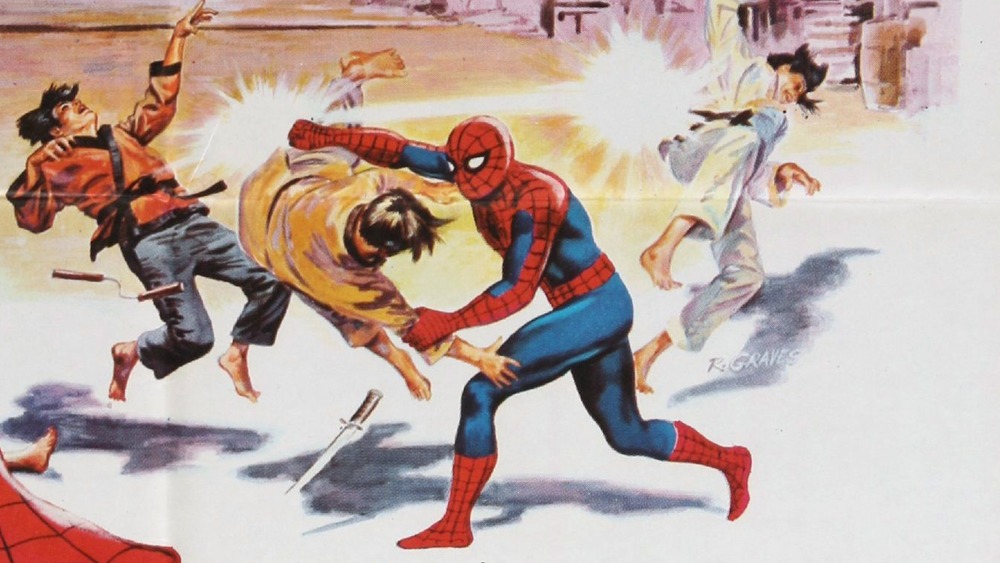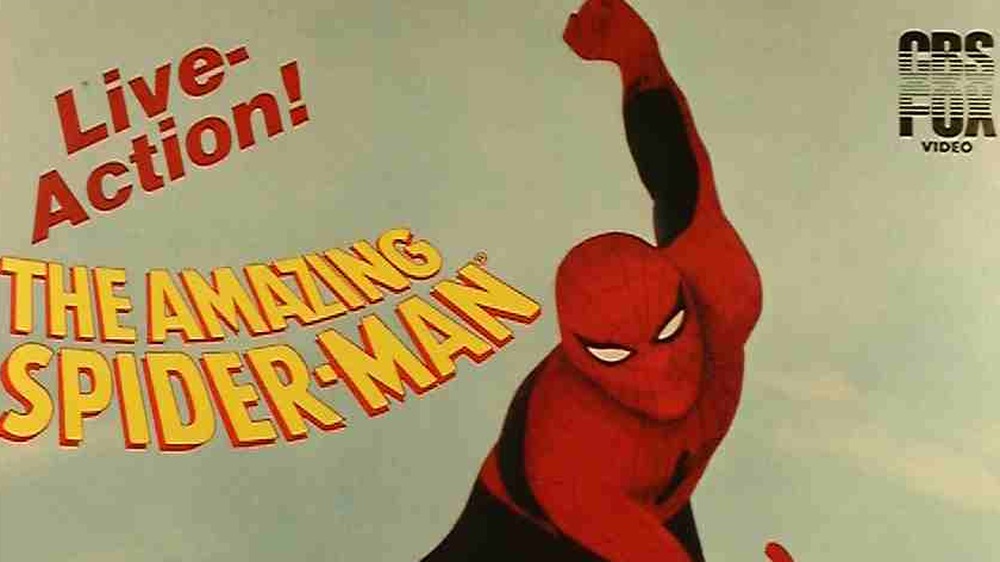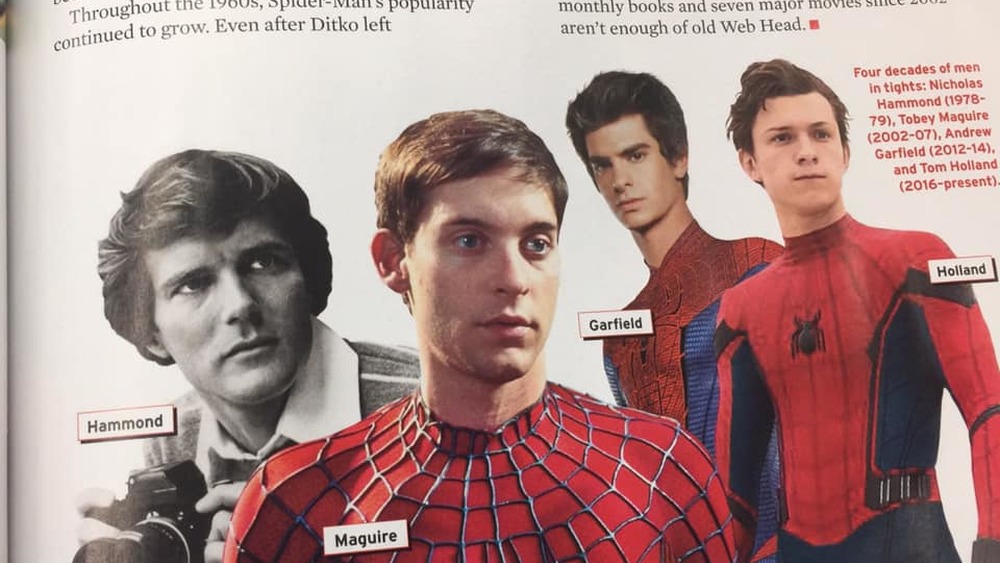The Original Live-Action Spider-Man Trilogy You Never Saw
We may receive a commission on purchases made from links.
In the 21st-century, Spider-Man is an all too common sight on movie theater screens. Starting with the 2002 movie Spider-Man, the famous Marvel Comics superhero has starred in eight different solo movies. His introduction into the Marvel Cinematic Universe with Captain America: Civil War has ensured that the character has only become even more prominent on the big screen. Thanks to his appearances in titles like Avengers: Infinity War, Spider-Man has managed to appear in a live-action movie in all but one year from 2014 to 2019 (2015 being the lone exception).
Thanks to this barrage of appearances, moviegoers are well aware of Spider-Man's cinematic exploits. But far more obscure is the very first trilogy of live-action Spider-Man movies. These motion pictures were spun off from a CBS TV show entitled The Amazing Spider-Man and were only given theatrical releases internationally. Given these qualities, it's no wonder they've proven more obscure to the public than the MCU Spider-Man outings. Though they may be minor entries in Spider-Man's film history, there are still plenty of strange and notable qualities in these three movies that make it worth remembering Spider-Man's first live-action trilogy.
Where did these Spider-Man movies come from?
These three Spider-Man movies weren't originally supposed to be movies. In fact, all three hail from the live-action TV show The Amazing Spider-Man that aired on CBS. Part of a wave of live-action superhero TV shows in the late 70s that also delivered The Incredible Hulk, The Amazing Spider-Man aired from 1977 to 1979. The feature-length pilot that kicked off this trilogy also served as a movie entitled Spider-Man, the first entry in this trilogy of Spider-Man movies. The subsequent two installments of the trilogy, Spider-Man Strikes Back and Spider-Man: The Dragon's Challenge, were comprised of two episodes each of the Amazing Spider-Man show.
Whereas modern Spider-Man movies get massive global theatrical releases, the original Spider-Man trilogy had a much more limited theatrical reach. Domestically, audiences only saw these episodes as part of Spider-Man's brief stint on the airwaves. In certain international territories, though, these episodes were repackaged as a trilogy of movies distributed by Columbia Pictures, who would go on to be Spider-Man's default movie distributor in the 21st century. Interestingly, this trio of movies helped to extend the shelf life of The Amazing Spider-Man. Though the program's final episode aired in July 1979, the final movie, Spider-Man: The Dragon's Challenge, ended up debuting theatrically in May 1981. Spider-Man is so enduring as a character that he was even able to give this forgotten TV show an extra few years of life.
The cast & crew for this Spider-Man trilogy
Despite being based on a TV show, the cast for this trilogy of Spider-Man movies was highly erratic. However, two actors provided a sense of consistency to the proceedings. Headlining all three movies is Nicholas Hammond as Peter Parker while Robert F. Simon portrays J. Jonah Jameson in each entry of the trilogy. Otherwise, a primarily new cast appears in each movie. This even applied to major characters who appeared in the comics. Jeff Donnell, for example, portrayed the character of Peter Parker's guardian, Aunt May. Despite May being a crucial character in Spider-Man's life, Donnell only appeared in the 1977 Spider-Man movie. Similarly, Chip Fields and Hilly Hicks portrayed Rita Conway and Robbie Robertson, respectively, for only one movie each.
The directorial approach across the three movies proved slightly more consistent compared to the casting. E.W. Swackhammer directed the original feature-length pilot for Spider-Man while Ron Satlof directed both of its sequels, Spider-Man Strikes Back and Spider-Man: The Dragon's Challenge. As for the screenplays, Alvin Boretz, Robert Janes and Lionel E. Siegel each wrote an installment of the trilogy. Interestingly, none of these men were prominent writers on the Amazing Spider-Man TV show. The episodes adapted for the silver screen were also the only ones these men ever wrote for the program (though Janes did write the story for one other episode). Once again, we see how the talent on this Amazing Spider-Man production rarely had much in the way of longevity.
Spider-Man (1977)
Peter Parker's debut live-action movie follows a plot familiar to anyone who's seen Tobey Maguire and Andrew Garfield's first takes on Spider-Man. Nicholas Hammond's debut as Spider-Man begins with the superhero's alter-ego, Peter Parker, getting bitten by a radioactive spider. Soon after, he discovers that he's been bestowed with extraordinary superpowers like being able to crawl up walls. Future incarnations of this storyline would see Parker facing off against Green Goblin and The Lizard. For this pilot, Spidey would go toe-to-toe with Edward Bryon (Thayer David), a guru who's hypnotizing New Yorkers to commit crimes. Clumsy fight scenes involving Bryon's henchman and an assortment of near-death experiences involving hypnosis ensue as Spider-Man does his best to stop Bryon.
Unlike the other two entries in this series, Spider-Man (1977) was always intended to be a feature-length story. In this era, it was a common practice for TV pilots to run this long, as was giving these projects international theatrical releases. Going down this route allowed the producers of pilots like Spider-Man (1977) to have their cake and eat it too. In the case of Spider-Man (1977), they got a domestic TV ratings hit and could garner even more money with an international theatrical release. Official box office figures for Spider-Man (1977) have never been released but the book Age of TV Heroes: The Live-Action Adventures of Your Favorite Comic Book Characters by Jason Hofius and George Khoury claims the production earned $9 million in overseas grosses.
Spider-Man Strikes Back
Whereas the 1977 Spider-Man movie dealt with villainy related to hypnosis, the sequel, Spider-Man Strikes Back, is all about nuclear warfare. The topic is explored through Spider-Man's confrontation with Mr. White (Robert Alda). Spidey's newest foe hatches a devious plan that involves bombing the World Trade Center. Much like the infamous finale of the 1976 King Kong, also set on the Twin Towers, Mr. White's evil plan makes watching Spider-Man Strikes Back in 2020 a far more uncomfortable experience than one would expect from a live-action Spider-Man movie. Thankfully, this isn't the only scheme Mr. White has concocted. Because this is two standalone episodes stitched together into a movie, Mr. White eventually moves on from nuclear weapons to an assassination attempt on the President of the United States. The film eventually ends with Mr. White escaping and promising to get his revenge on Spider-Man. Given that Mr. White never appeared again, this was a promise he couldn't keep, which, as Spider-Man knows, is the best kind of promise.
Whereas the previous Spider-Man movie got a general theatrical release internationally, Spider-Man Strikes Back was given a far more restrained theatrical launch. Only a handful of European territories, including Germany, screened the title. Its overseas theatrical presence was so minimal that there are no recorded box office figures for the project. Much like Mr. White leaving the scene of a dastardly crime, Spider-Man Strikes Back vanished from theaters without a trace.
Spider-Man: The Dragon's Challenge
Wrapping up the trilogy was Spider-Man: The Dragon's Challenge, which saw the web-crawler facing off against Zeider (Richard Erdman), a wealthy man who wants to kill an old colleague of J. Jonah Jameson by the name of Min Lo Chan (Benson Fong). With incriminating information on Zeider in his possession, Min Lo Chan's life is in constant danger. The only person who could possibly protect Lo Chan and his niece Emily (Rosalind Chao) from these threats is Spider-Man. Thus, the web-crawler ends up protecting Min from the various bruisers Zeider sends to assassinate him. Eventually, Peter Parker uses his wits to expose Zeider and his treachery, thus preserving the life of Min Lo Chan.
Like Spider-Man Strikes Back, The Dragon's Challenge received a minor theatrical release in international territories, with this particular entry screening in countries such as Australia. Also like its predecessor, The Dragon's Challenge has never reported box office figures for its theatrical run. This means that the largest legacy of this project is two members of its supporting cast. Firstly, there was Rosalind Chao. She scored an early acting credit here before going on to appear in numerous TV shows and movies, including the Marvel Comics adaptation Shang-Chi and the Legend of the Ten Rings. Also appearing in Spider-Man: The Dragon's Challenge, in the role of Major Collins, was Ted Danson. When the episodes comprising this movie originally aired in 1978, Collins served as only Danson's third credited acting appearance.
The trilogies lack an overarching story
In many trilogies, an overarching story is easily discernible. Across the various Star Wars trilogies or the Lord of the Rings trilogy, trios of movies often function as much as pieces in a broader narrative as they do standalone movies. In many cases, the individual movies in a trilogy even fulfill the same function as the pieces of a three-act story (i.e. the first movie is the first act, and so on). With this inaugural Spider-Man trilogy, no such sprawling narrative exists for the simple reason that these were not meant to be an interconnected series of films. There's a sense of disconnect across the three movies that makes it thoroughly unique among movie trilogies, particularly ones starring superheroes.
The original 1977 Spider-Man is a standalone feature-length pilot meant to introduce viewers to the idea of weekly Spider-Man adventures rather than set up feature-length sequels. As for the two follow-ups, much like the 2008 Clone Wars movie, they're each merely multiple episodes of a TV show jammed together. This explains why Spider-Man Strikes Back, for example, stops and starts its plot for two wildly different evil plans from Mr. White. Each plan was originally the center of its own TV episode rather than two halves of a movie. This results in very little storytelling cohesion across these Spider-Man features as individual properties, let alone across the ramshackle trilogy as a whole.
New characters everywhere
While their stories don't blend together, there is one recurring detail across all three of these Spider-Man movies: an abundance of new characters. Modern-day Spider-Man movies like Spider-Man 3 or The Amazing Spider-Man 2 tend to cram in as many supporting figures from the main character's comic book roots as possible. By contrast, much like the TV show they spun off from, these Spider-Man movies primarily use newly created characters.
With the exception of J. Jonah Jameson, who appears in all three movies portrayed by Robert F. Simon, Spidey's supporting cast in these movies is almost entirely new. For instance, in the first Spider-Man movie, Judy Tyler is the most prominent woman in Peter Parker's life instead of Gwen Stacy or Mary Jane Watson. Spider-Man's best friend Harry Osborn is also absent from all three features. The presence of new characters is especially notable when it comes to the trilogy's villains. Instead of facing off against seminal foes like Green Goblin or Kraven the Hunter, international moviegoers were treated to the sight of Spidey waging war against Edward Bryon and Mr. White. None of the oversized figures in colorful costumes that usually pick a fight with Spider-Man would be found here.
The lack of Spidey's iconic supporting cast and foes from the comics explain a lot as to why these movies didn't win over comic book devotees. They also reinforce how these three movies are such strange outliers in Spider-Man's feature film career.
Reception
Varying degrees of reception have greeted the various 21st century Spider-Man movies, but all of them garnered better marks than the original three Spider-Man movies. A retrospective review of the 1977 Spider-Man movie from JoBlo described the project as "just inherently goofy and cheesy at every turn, and proof that you can't really bring a super-powered character to life while pinching pennies." This response established a number of recurring criticisms for the three movies, in particular the low-budget nature of these productions. Though presented theatrically overseas, the TV origins of these Spider-Man movies was readily apparent on the screen.
Reviews for the follow-ups didn't get any better. Spider-Man Strikes Back was reviled by The Dissolve for many reasons, including the fact that "Spider-Man doesn't throw his first punch until the film is half over." Meanwhile, the conclusion of the trilogy, Spider-Man: The Dragon's Challenge, was declared by Inverse to be "the worst Spidey movie ever made" due to the film's overwhelmingly tedious nature. While each of the individual films drew their own unique criticisms, the critical reception to the first trilogy of Spider-Man movies was subpar across the board.
Worst of all, though, was that Spider-Man co-creator Stan Lee was critical of the TV show that spawned these three movies. Echoing modern complaints about the lack of personality in this original Spider-Man trilogy, Lee once said of the show that "They left out the humor. They left out the human interest and personality and playing up characterizations and personal problems."
Where are these three movies available to watch today?
Usually, anything with the Spider-Man logo is guaranteed to get some form of release. But there are limits to everything, and even the lucrative nature of the character hasn't guaranteed new home video releases for these three movies. Though put out on VHS in the 1980s, the original live-action Spider-Man trilogy hasn't found its way into any other home media format since. This mirrors the scarcity of the Amazing Spider-Man TV show, which has been entirely denied a proper home video release save for a handful of episodes making their way onto VHS. By contrast, the Spider-Man show from Japan, released in the same era as The Amazing Spider-Man, has managed to get released on physical home media in Region 2 markets.
The age of streaming has offered no salvation for the increased availability of these original three Spider-Man movies. They have never appeared on any streaming platform and no plans have been announced to have them air alongside other Spider-Man programming on Disney+. The negative reception associated with the program, as well as a lack of a major fanbase to champion for its release, has led to these three Spider-Man movies gathering dust on a shelf somewhere in a corporate vault.
The legacy of the original Spider-Man trilogy
While comic books are the go-to source of creative inspiration for adaptations of Marvel Comics characters, certain TV shows, like The Incredible Hulk, have managed to leave a lasting creative legacy. Such was not the case with this trilogy of Spider-Man movies. Much like the TV show they spun off from, these Spider-Man films have mostly vanished from the pop culture consciousness.
Part of that is due to the trilogy's reliance on a down-to-Earth vision of Spider-Man. The lack of exciting or strange elements in these films has kept them from turning into a cult hit like the 1970s Japanese Spider-Man show. The lack of a proper home video or streaming release has similarly ensured that the first three Spider-Man movies have become a pop culture footnote. To boot, the property's longevity has been hurt by how it hasn't been referenced in other Spider-Man media. Whereas even the Turn Off the Dark Spider-Man almost got referenced in Spider-Man: Into the Spider-Verse, the first live-action take on Spider-Man has been ignored.
One exception to this phenomenon came in the 2019 edition of Entertainment Weekly's The Ultimate Guide to The Avengers. Within this special magazine was a small graphic (pictured above) that displayed the various actors who have portrayed Spider-Man in the movies. Tobey Maguire, Andrew Garfield, and Tom Holland were all pictured... as was Nicholas Hammond. It was a rare moment of recognition for the actor that first took the web-crawler to the movies.
